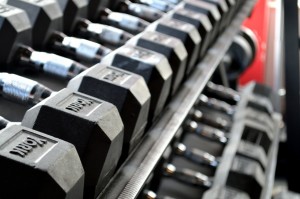Ask a fitness professional what type of routine a beginner should follow, and 90 times out of 100, you’ll get the answer “a full body workout.”
(9 of the 100 will probably say an upper-lower split, and 1 downright shady character with fewer brain cells than a 20 kilo plate will say The Tracy Anderson Method, but that’s by the by.)
All told, a full body workout is an ace way for anyone new to weight training to earn their lifting stripes.
Why?
Foremost – frequency.
When you start lifting, you’re not going to be able to handle a huge amount of volume each session, but you will respond best to lifting more often, as your body is primed to adapt neurally, and so strength gains will come quicker the more often you train, provided you recover fully.
Secondly, compound moves provide enough stimulation for smaller muscles to grow too.
An advanced lifter wouldn’t really get a great biceps workout just from doing rows, or see their calves grow purely form squats and deadlifts, but a beginner would, hence they see pretty even total body growth just from a small number of exercises.
Finally, full body sessions enforce the basics, and ensure that you’ve got a good grasp of the foundations – i.e. compound barbell, dumbbell and bodyweight moves.
The Trouble With Full Body Workouts
Most of them suck.
It’s true.
I don’t mean that they’re poorly put together, or don’t work if followed correctly, more that they’re really boring.
There’s an argument that if you’re getting bigger and stronger, that keeps training interesting, but I know that personally, it wouldn’t matter how quickly I was progressing, I’d soon become bored with only doing back squats, conventional deadlifts, bench presses, bent over rows, and maybe the odd set of military presses and chin-ups three times per week.
Hence, when I give a full-body workout to a client, I make sure it’s something that has variety in it too.
We’re not talking crazy exercise switches, or buying into the bogus idea of muscle confusion, rather meshing the need to train movement patterns frequently, with the desire for variety to keep things – dare I say it – fun.
So if you’re bored with your current full body routine, or just starting out and want something a little different to try, take a look at the following 3-day-per-week full body template.
Session 1
| Exercise | Sets x Reps | |||
| Week 1 | Week 2 | Week 3 | Week 4 | |
| 1a) Barbell Back Squat | 3×10 | 3×8 | 4×6 | 5×5 |
| 2a) Speed Deadlift * | 6×3 | 6×3 | 8×2 | 8×2 |
| 3a) Incline Bench Press | 3×8 | 3×8 | 3×8 | 3×8 |
| 3b) Close-Grip Cable Row | 3×12 | 3×12 | 3×12 | 3×12 |
| 4a) Face Pulls | 2×20 | 2×20 | 2×20 | 2×20 |
| 4b) Lateral Raises | 2×15 | 2×15 | 2×15 | 2×15 |
| 4c) Dips | 2x Max | 2x Max | 2x Max | 2x Max |
* These should be done at around an effort level 6 out of 10. The focus is on perfect technique and speed off the floor.
Session 2
| Exercise | Sets x Reps | |||
| Week 1 | Week 2 | Week 3 | Week 4 | |
| 1a) Deadlift | 4×6 | 4×5 | 5×4 | 5×3 |
| 2a) Front Squat | 3×8 | 3×8 | 3×6 | 3×6 |
| 3a) Paused Bench Press | 3×6 | 3×6 | 3×5 | 3×5 |
| 3b) Chins (Weighted or assisted if needed) | 3×12 | 3×10 | 3×8 | 3×6 |
| 4a) Tricep Pushdowns | 2×15 | 2×15 | 2×12 | 2×12 |
| 4b) Dumbbell Curls | 2×15 | 2×15 | 2×12 | 2×12 |
| 4c) Calf Raises | 2×15 | 2×15 | 2×12 | 2×12 |
Session 3
| Exercise | Sets x Reps | |||
| Week 1 | Week 2 | Week 3 | Week 4 | |
| 1a) Paused Back Squat | 3×8 | 3×8 | 3×6 | 3×6 |
| 2a) Trap Bar or Block Deadlift | 2×8 | 2×6 | 3×6 | 3×5 |
| 3a) Bench Press | 3×10 | 3×8 | 4×6 | 5×5 |
| 3b) Barbell Row | 3×15 | 3×12 | 3×10 | 3×8 |
| 4a) Seated DB OHP | 3×12 | 3×12 | 3×10 | 3×8 |
| 4b) Barbell Shrugs | 3×20 | 3×15 | 3×12 | 3×10 |
| 4c) Lat Pulldown | 3×15 | 3×15 | 3×12 | 3×12 |
Notes
- Use a sensible tempo (1-2 seconds to lower, around a 1 second pause, and then an explosive lifting portion) on every rep.
- Work to around an RPE 8 on each exercise. This means you have 2 reps left in the tank. There is NO NEED to work to failure, unless stated. Use perfect technique, and if you feel your form deteriorating before the target reps, lower the weight for the next set.
- The letters refer to a superset or tri-set, where you don’t take any rest between exercises.
- Unless you’re doing a superset or tri-set, keep rest periods to 2-4 minutes when working in the 3 to 8 rep range, and 1-2 minutes for everything else.
- Perform between 1 and 3 light warm-up sets before each exercise.
The Wrap Up: Full Body Training Doesn’t Have to Be Boring
It isn’t all about low-bar back squats and 5×5 when it comes to full body training.
The above split has ample variety that you won’t start to dread the gym, but enough frequent stimulation of similar movement patterns that you’ll get just as strong (if not stronger) as you would doing the same exercises every workout.
The rotation of rep ranges means you’re training is periodised too, which is one key criticism of many beginner programs.
Once you’ve finished the 4-week block, take a deload where you perform your regular workouts, but cut the sets in half and drop your weights to around 60-70% of what you’d usually use, then jump back into week 1 again, going heavier than you did first time round.
You can change exercises around if you wish, just for the love of god don’t start adding in glute kickbacks, Smith machine squats or bicep curls on a BOSU ball. Change is good, but that much change will seriously screw with your gains.
About The Author:
Mike Samuels runs online coaching business Healthy Living Heavy Lifting.
He loves flexible dieting and specializes in getting clients lean while eating cake and ice cream!
Mike has competed in men’s fitness and bodybuilding competitions, and is also a record holder in the Great British Powerfliting Federation.
You can contact him at –



